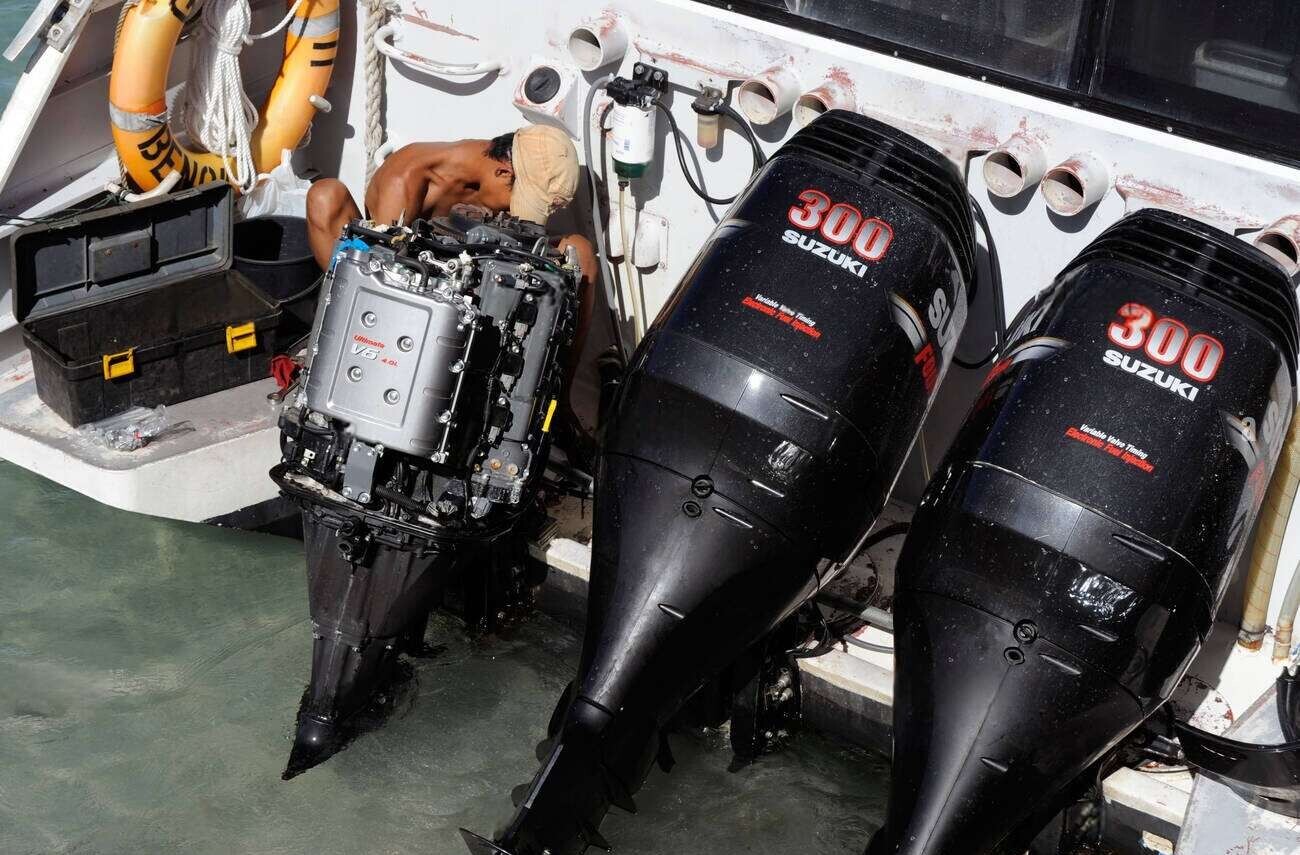Suzuki Outboard Motor Parts: Breakdown & Maintenance Tips
The reliable hum of the Suzuki outboard is a soundtrack for many seasoned boaters and anglers. If you are a Suzuki outboard owner, the odds are that you already know how good your engine is. They are constructed well, run well, and do not give you many problems until something does go wrong. And should it, it’s helpful to have a clue about what’s happening under the hood.
This isn’t about going all super technical or ripping the entire thing apart. It’s all about knowing the important pieces, how they interact and working together, and what symptoms to monitor if something goes wrong.
This comprehensive guide breaks down the essential parts of Suzuki outboards and provides the knowledge to maintain, troubleshoot, and choose the correct parts for your valuable investment.
Breaking Down the Suzuki Outboard Motor Parts

Alamy/ClaudeThibault
Let’s lift the cowling and explore the critical systems that make your Suzuki outboard tick. Understanding each section makes it easier to identify issues, perform maintenance, and appreciate the engineering beneath the surface.
1. Internal Combustion System
This is the core of your outboard, where fuel is converted into power. The system involves a series of processes, including fuel intake, compression, ignition, and exhaust, all happening within the engine’s cylinders. The process results in gas expansion from combustion, which pushes a piston that rotates the crankshaft and powers the propeller.
The Suzuki internal combustion system contains the following components:
- Pistons & Cylinders
- Connecting Rods
- Crankshaft
- Camshaft & Valves
- Cylinder Head & Gaskets
- Bearings
2. Fuel System
A clean and consistent fuel supply is paramount for your outboard's performance. The outboard fuel system maintains a consistent and calculated supply of fuel to ensure optimal performance, fuel economy, and emissions.
- Fuel Pump
- Fuel Injectors (for EFI models) / Carburetor (for older models)
- Fuel Filters & Water Separators
- Fuel Lines & Hoses
- Fuel Vapor Separator Tank (VST)
3. Lower Unit Components
This is the transmission and drivetrain of your outboard motor submerged in the water. It transfers the engine’s power to the water, enabling the boat to move. The lower unit is constantly exposed to harsh marine environments, which means you have to make regular maintenance to maintain optimal performance.
- Propeller
- Drive Shaft
- Propeller Shaft
- Gears (Forward, Reverse, Pinion)
- Shifting Mechanism
4. Ignition System
The spark that ignites the power. The system ignites the air-fuel mixture, initiating the combustion process and enabling the engine to run. It is a complex system that involves the following components:
- Spark Plugs
- Ignition Coils
- CDI Unit (Capacitor Discharge Ignition)
- Stator/Flywheel
- Rectifier/Regulator
- Ignition Switch & Kill Switch/Lanyard
5. Cooling System
The outboard engine cooling system uses water to regulate the temperature, preventing overheating. The cooling system draws water and circulates it through the engine’s cooling passages to absorb the heat. Keeping your engine at the optimal operating temperature is crucial for both longevity and the outboard cooling system’s efficiency.
These are the main components of a cooling system:
- Water Pump (Impeller & Housing)
- Thermostat
- Water Tubes/Hoses
- Sacrificial Anodes
6. Electrical Parts
The electrical system is the nervous system of your outboard. It provides the necessary power for starting, running, and various other functions. A Suzuki outboard motor has the following parts.
- Battery
- Wiring Harness
- Alternator
- Voltage Regulator
- Sensors
- Relays and Fuses
7. Control System
It is your direct interface with the outboard’s power. This system controls speed, direction, and other settings, enabling the captain to maneuver the boat effectively. The control system contains the following parts:
- Throttle & Shift Controls
- Power Trim and Tilt System
- Steering System
8. Lubrication System
A lubrication system is a crucial component of your outboard engine. It reduces friction, improves performance, and enhances reliability. The system delivers oil to critical engine components like the crankshaft, connecting rods, and camshaft, ensuring proper lubrication and reducing wear and tear.
- Engine Oil
- Oil Pump
- Oil Filters
- Oil Pan
- Oil Sensors
Common Issues and Troubleshooting with Suzuki Outboard Motors
Suzuki outboard motors are generally reliable engines. While not prone to major damage or extensive repairs, they can experience minor issues, as discussed below.
Suzuki Outboard Not Starting
If your Suzuki outboard engine is not starting, there may be several potential problems. If your outboard is not powering, start from the most obvious causes, then move to more complicated possibilities. Here’s a run-down:
- Check if the kill cord is attached
- The Suzuki outboard will not start in gear. Make sure the engine is in neutral.
- Inadequate fuel supply is a common issue; it can be due to pinched hoses or a lack of fuel in the gas tank.
- If there is water in the fuel lines, the engine won’t start. Perform a visual inspection of the water separator bowl for traces of water.
- Look for fouled spark plugs; the problem is more common in small engines. If you have a fouled spark plug, replace it with a new one.
- Test your battery to ensure that it has been adequately charged. Corroded battery terminals can also lead to similar issues. If it has been underperforming for a long time, then you should consider replacing it. Similarly, corrosion prevention is essential to prevent starting issues and any other outboard problems.
Suzuki Outboard Engine Misfiring
Now you have started your Suzuki outboard engine, but you still experience a rough or uneven idle. There can be many possible causes of why your outboard is misfiring.
- Fuel quality is a big factor when your Suzuki outboard is running roughshod. The introduction of high-ethanol marine fuel or water into the fuel can lead to misfires.
- Short out electrical connections can lead to misfires. This is common for improperly winterized boats or those stored near aquatic environments.
- Look for loose connectors that may have vibrated off. Suzuki outboards show a warning for a faulty component on the instrument panel to help you service your outboard.
- A faulty fuel pump can lead to a rough, uneven idle by reducing or increasing the fuel supply. Consider replacing the fuel pump completely to resolve the issue.
Learn: How to properly winterize your outboard engine?
Overheating Suzuki Outboard Motor
One of the most common ways an outboard can fail is when it overheats during use. If the temperature gauge is red, seeing or smelling smoke, or uneven performance, the following are some common reasons for overheating Suzuki outboards.
- First, look at your instrument panel for a warning alerting you to the issue.
- A blocked water intake is the most common cause of overheating. Remove the debris and verify the performance by looking for water coming out of the telltale hole.
- A worn, clogged, or misshapen water pump impeller can reduce the ability to cool the engine. It leads to an overheated engine, triggering a mechanism that prevents the engine from functioning at high temperatures. The Suzuki impeller should be replaced immediately.
Suzuki Outboard Hesitates on Acceleration
An outboard that hesitates to throttle up can have a range of different problems:
- A closed or blocked air vent on the fuel tank is a top reason. Ensure that the air vent is open and free from obstructions. Look underneath the cowling for any debris, especially animal nests, leaves, and tree sap.
- Dirty or restricted fuel filters can cause intermittent acceleration issues. Check your fuel filter and remove any restrictions. If the problem persists, replace it with a genuine OEM Suzuki oil filter.
- Thoroughly inspect the fuel lines for poor connections, pinched lines, damage, and leakage issues.
- Make sure that the fuel pump is in proper working condition. A malfunctioning fuel pump will cause uneven acceleration until it eventually degrades. Replace the Suzuki outboard fuel pump as soon as you feel it's not working well.
Maintenance Essentials that You Should Have in Your Garage
Being prepared for routine maintenance and minor issues can save you time, money, and headaches. Here are some essentials for your marine garage.
- Basic Tool Kit
- Engine Oil & Gear Lube
- Oil Filters & Fuel Filters
- Spark Plugs
- Water Pump Impeller Kit
- Sacrificial Anodes
- Marine Grease
- Fuel Stabilizer
- Diagnostic Tools
These essentials can help you perform regular maintenance and tackle minor repairs before they escalate.
Choosing the Right Suzuki Engine Parts: Ensuring Compatibility and Longevity
When it comes to replacing parts for a Suzuki outboard, making the right choice is crucial for performance, reliability, and safety.
Understand Part Numbers
Every genuine Suzuki part has a unique part number. This number is your best friend when ordering replacements. It ensures you get the exact component designed for your specific engine model and year.
You can typically find the part number in your owner’s manual, an exploded parts diagram, or sometimes it is stamped directly on the part. So, understand the Suzuki outboard part number format and easily search for the part by its number to find the correct components. OBParts offers easy search and model filters to help you find what you need.
OEM vs Aftermarket Parts
OEM vs Aftermarket outboard parts is a big question for boaters and anglers.
OEM parts come directly from Suzuki or certified partners and are designed to exact specs. Aftermarket parts are also designed to exact specs, but you can expect various quality classes. We recommend sticking to the OEM specifications for critical components like impellers, seals, or ignition systems.
Reputable Sellers
Purchasing from reputable sellers is just as important as choosing the right type of part. Always look for:
- Authorized Sellers: They deal in authentic OEM components and usually have certified mechanics.
- Established Online Retailers (OBParts): Search for vendors with accurate product descriptions, user-friendly part finders, positive customer comments, and prompt customer service. Furthermore, a professional online retailer will specify whether a part is OEM or aftermarket.
Additionally, assess other value-added features, such as well-defined return policies, fit and installation guides, fast shipping and returns, and superior customer service.
Conclusion
Suzuki outboard motors are a reliable and high-performing engine that relies on precisely engineered parts. From the power internal combustion system and precise fuel delivery to the critical cooling and lubrication systems, understanding these intricate components plays a role in ensuring safe, smooth, and fuel-efficient boating.
By proactively maintaining your Suzuki with the right parts, you will ensure its optimal performance, effectively troubleshoot issues, and enjoy countless hours of reliable boating.
Posted by Brian Whiteside


